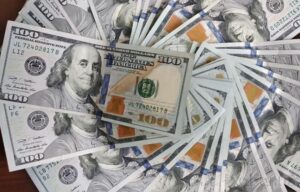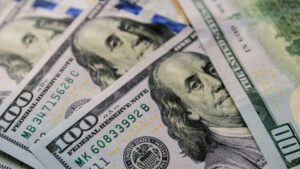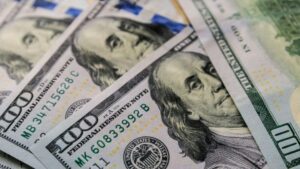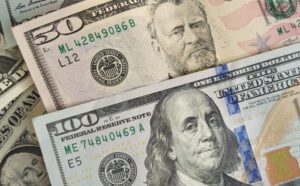
The US dollar rate was almost unchanged against the euro and the pound sterling on Friday morning, but demonstrated an active rise in pair with the yen on the results of the Bank of Japan meeting.
The ICE-calculated index showing the U.S. dollar’s performance against six currencies (euro, Swiss franc, yen, Canadian dollar, pound sterling and Swedish krona) was down less than 0.1% during this morning’s session. The broader WSJ Dollar Index was up less than 0.1%.
The euro/dollar pair is trading at $1.0589 as of 8:00 a.m., versus $1.0585 at the close of Thursday’s session.
The pound sterling is trading at $1.1925 versus $1.1924 at the close of last session.
Foreign exchange market participants took a wait-and-see attitude ahead of Friday’s publication of statistical data on the U.S. labor market.
The Labor Department report will be released at 3:30 p.m. and analysts polled by Trading Economics expect it to show the unemployment rate will remain at 3.4 percent and the number of jobs in the U.S. economy will climb by 205,000.
Strong labor market data could be an important argument for the Fed to raise interest rates by 50 basis points at the March meeting. The market generally expects just such a scenario, although last week’s consensus forecasts called for a hike of just 25 bps.
Meanwhile, the dollar-yen exchange rate rose 0.4% to 136.65 yen against 136.14 yen the day before.
On Friday, the Bank of Japan expectedly didn’t change the main parameters of the monetary policy on the results of the meeting, which was the last for the head of the central bank Haruhiko Kuroda who heads the bank since 2013.
Japan’s parliament this week approved Kazuo Ueda as the next head of the central bank. He will lead the Bank of Japan on April 8, when Kuroda’s term expires. The next meeting will be held under his leadership on April 27-28.

The U.S. dollar is stable against the euro and the yen in trading on Tuesday and is weak against the pound.
The market is waiting for Federal Reserve (Fed) Chairman Jerome Powell’s semiannual report on monetary policy, which he will deliver before the Senate Banking Committee and the U.S. House Financial Services Committee on Tuesday and Wednesday, respectively.
Also this Friday, the U.S. unemployment figures for February will be released.
Powell is unlikely to say anything definitive about the further pace of the prime rate hike, since the key data that will affect the Fed’s decisions during the March meeting will be released after his remarks.
“The Fed wants to see more statistical data before it makes its next moves,” notes MacroPolicy Perspectives Chief Economist Laura Rosner-Whorbaton, quoted by Market Watch.
“Powell is likely to emphasize that the Fed still has a lot of work to do to fight inflation,” she says. – The Fed’s work is not over, and the central bank will continue to do it until it does it completely.”
The ICE-calculated index showing the dollar’s performance against six currencies (euro, Swiss franc, yen, Canadian dollar, pound sterling and Swedish krona) is losing 0.11% in trading, while the broader WSJ Dollar Index is adding 0.02%.
The euro/dollar pair is trading at $1.0685 as of 8:15 a.m., up from $1.0686 at Monday’s market close.
The pound/dollar exchange rate rose to $1.2040 from $1.2028 at the close of the previous session.
The U.S. currency pair with the yen rose to 135.94 yen from 135.92 yen the day before.
The rate of Australian dollar weakened to $0.6704 from $0.6730 at the close of previous trading session.
The Reserve Bank of Australia (RBA) on Tuesday raised its key interest rate by 25 basis points (bps) to 3.6% a year. This is the tenth increase in the cost of credit since last May, the rate was raised by 350 bps in total and is at its highest since May 2012.
Statement of the Australian Central Bank, however, was less “hawkish” than in the past, notes Market Watch. RBA stated that inflation in the country, probably, has already reached its peak level, and further decisions on tightening of monetary policy will depend on statistical data.

The U.S. dollar is falling moderately against the euro and the yen on Monday morning, while strengthening weakly against the pound sterling.
The ICE-calculated index, which shows the U.S. dollar’s dynamics against six currencies (euro, Swiss franc, yen, Canadian dollar, pound sterling and Swedish krona), declined 0.1% during the morning session.
The euro/dollar pair was trading at $1.0646 as of 8:20 a.m. Q, versus $1.0635 at the close of last Friday’s session, with the euro adding about 0.1%.
The pound sterling is down 0.1% and is trading at $1.2031 versus $1.2043 at the close of last session.
The dollar-yen exchange rate is down 0.1% and trades at 135.76 yen.
Foreign exchange market participants are assessing the statements of the Federal Reserve (Fed) representatives, trying to predict the future trajectory of interest rates.
For example, Mary Daley, head of the Federal Reserve Bank of San Francisco, said last weekend that the Fed rate could stay high for a long time because of sustained inflation.
“To put a period of high inflation behind us, we will probably need more monetary tightening to persist for longer,” she said during a speech at Princeton University.
The Fed’s next meeting is March 21-22.
Meanwhile, the exchange rate of the yuan traded in mainland China is 6.9102/$1, compared with 6.9074/$1 at the close of the previous session.
As reported, the Chinese government set the target growth rate for the country’s economy this year at about 5%. Meanwhile, many economists expected the target to be more ambitious.
Analysts at Swiss bank UBS raised their forecast for Chinese economic growth in 2023 to 5.4 percent from the previously expected 4.9 percent. The growth estimate for 2024 was raised to 5.2% from 4.8%.
EURO, pound, U.S. dollar, yen

The U.S. dollar is getting cheaper against the euro, the yen and the pound sterling in trading on Friday after a strong strengthening at the end of the previous session.
The ICE-calculated index showing the dollar’s dynamics against six currencies (euro, Swiss franc, yen, Canadian dollar, pound sterling and the Swedish krona) lost 0.21% in trading, while the broader WSJ Dollar Index lost 0.2%.
The euro/dollar pair is trading at $1.0616 as of 8:20 a.m., up from $1.0597 at market close Thursday.
The pound/dollar exchange rate rose to $1.1977 from $1.1947 the day before.
The value of the U.S. currency in a pair with the yen dropped to 136.46 yen from 136.77 yen at closing of the previous session.
On Thursday the dollar gained 0.7% against the euro and the pound and 0.4% against the yen. Signals of a resilient U.S. labor market confirmed investors’ belief that the Federal Reserve (Fed) may raise the benchmark interest rate higher than previously planned.
However, statements from Atlanta Federal Reserve Bank (Fed) President Rafael Bostick, in which traders saw dovish signals, calmed the market somewhat.
Bostick, who does not have a vote on the Federal Open Market Committee (FOMC) in 2023, said during a press briefing Thursday that he would support a 25 basis point (bps) increase in the Fed’s benchmark interest rate at the March meeting. He noted that the U.S. central bank, in his view, should proceed cautiously, given the pent-up effect of policy tightening that could manifest itself soon.
When asked when the Fed stops the cycle of raising the rate, Bostic said that the appropriate situation for this may occur by mid-end of the summer of this year, Bloomberg reported.
Fed Board of Governors member Christopher Waller said Thursday that if the next batch of statistics on the U.S. economy shows slowing inflation and some weakening of the labor market, he would be willing to support “a couple more hikes” of the Fed rate – to a maximum of 5.1-5.4 percent from the current 4.5-4.75 percent.
“However, if this data continues to show that U.S. economic activity remains too ‘hot,’ we will need to raise the rate above that level to be sure that the momentum for easing inflation is not lost,” Waller said.

The U.S. dollar is becoming cheaper in pairs with the pound and the euro, but it is slightly stronger against the Japanese yen.
The ICE-calculated index showing the US dollar’s dynamics against six currencies (euro, Swiss franc, yen, Canadian dollar, pound sterling and the Swedish krona) is down less than 0.1% in the morning session.
The euro/dollar pair is trading at $1.0599 as of 8:18 a.m. versus $1.0587 at the close of Tuesday’s session, with the euro adding about 0.2%.
Investors continue to evaluate statistical data and statements by Federal Reserve (Fed) officials to try to predict future interest rate changes.
Judging by the rate futures, market participants see some probability that at the next meeting of the Federal Reserve the rate will be increased by 50 basis points at once, though earlier investors were sure that the central bank will now change the rate in steps of 25 bps.
Overall, the market is expecting a rate hike to peak at 5.25-5.5% from the current 4.5-4.75%.
The pound is up 0.2% at $1.2049 versus $1.2023 at the close of last session.
The dollar is up 0.1% against the yen, trading at 136.37 yen.
Meanwhile, the yuan, which is traded in mainland China, jumped against the dollar by 0.4% to 6.9035/$1.
As reported, Purchasing Managers Index (PMI) in the processing industry in China rose to 52.6 points in February from 50.1 points a month earlier. Experts on average had expected a more moderate increase to 50.5 points.
The service sector PMI rose to 56.3 points in February from 54.4 points in January. The indicator reached its highest level since March 2021.
The index value above the mark of 50 points indicates an increase in business activity, below it – a decrease.

The U.S. dollar is strengthening against the euro, the yen and the pound sterling in trading on Tuesday amid market revisions of expectations for the Federal Reserve (Fed) rate peak.
The ICE-calculated index showing the dollar’s performance against six currencies (euro, Swiss franc, yen, Canadian dollar, pound sterling and Swedish krona) added 0.17% in trading, while the broader WSJ Dollar Index gained 0.16%.
The euro/dollar pair is trading at $1.0585 as of 8:15 a.m., up from $1.0611 at Monday’s market close.
The pound exchange rate had dropped to $1.2041 by that time from $1.2065 the day before.
The value of the American currency against the yen is 136.31 yen against 136.23 yen at the end of the previous session.
The futures market expects the Fed’s rate to peak at 5.4% this year, although a month ago the maximum rate was estimated at 5%, Bloomberg noted.
The adjustment of traders’ expectations is related to signals of the sustainability of inflation in the U.S. According to the data published on Friday, the consumer price index (PCE index) in the states in January increased by 0.6% against the previous month (the maximum increase for six months), and in annual terms it rose by 5.4%. The rate of growth accelerated compared to December, when it was 0.2% and 5.3%, respectively.
Statistical data from the euro zone, to be released Thursday, are expected to show some easing of inflation in the region in February. The consensus analyst forecast cited by Trading Economics expects the euro area’s consumer price growth rate to slow to 8.2% on an annualized basis this month from 8.6% in January.
However, the rate of consumer price growth excluding food and energy (CPI Core, a core inflation indicator) is expected to remain at 5.3%, a record high.
The swap market expects the ECB deposit rate, currently at 2.5%, to rise to 3.9% in February 2024.